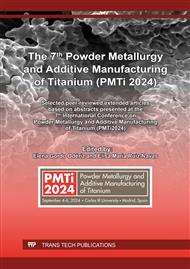[1]
M.J. Donachie, Titanium a technical guide, ASM, 1988.
Google Scholar
[2]
E.W. Collings, The physical metallurgy of titanium alloys, American Society for Metals, 1983.
Google Scholar
[3]
V.A.R. Henriques, Titanium production for aerospace applications, Journal of Aerospace Technology and Management, 1, (2009) 7–17.
Google Scholar
[4]
A. Dehghan-Manshadi, MJ. Bermingham, M.S. Dargusch, D.H. StJohn, M. Qian, Metal injection moulding of titanium and titanium alloys: Challenges and recent development, Powder Technology, 319 (2017) 289–301.
DOI: 10.1016/j.powtec.2017.06.053
Google Scholar
[5]
M.C.C. Ueta, C.A. Fracote, V.A.R Henriques, M.L.A. Graça, C.A.A Cairo, Densification study of titanium powder compacts,Materials Science Forum, 498-499 (2005) 211–216
DOI: 10.4028/www.scientific.net/msf.498-499.211
Google Scholar
[6]
R.M. German, Progress in Titanium Metal Powder Injection Molding, Materials, 6 (2013) 3641-3662.
DOI: 10.3390/ma6083641
Google Scholar
[7]
F.H. Froes, Advances in titanium metal injection molding, Powder Metall. Met. Ceram., 46 (2007) 303–310.
DOI: 10.1007/s11106-007-0048-y
Google Scholar
[8]
Lin Dongguo et ali, Rheological and thermal debinding properties of blended elemental Ti-6Al-4V powder injection molding feedstock, Powder Technology, 311 (2017) 357–363.
DOI: 10.1016/j.powtec.2016.12.071
Google Scholar
[9]
G. Thavanayagam, K.L. Pickering, J.E. Swan, P. Cao, Analysis of rheological behavior of titanium feedstocks formulated with a water-soluble binder system for powder injection molding, Powder Technology, 269 (2015) 227–232.
DOI: 10.1016/j.powtec.2014.09.020
Google Scholar
[10]
A. Mannschatz, S. Hohn, T. Moritz, Powder-binder separation in injection moulded green parts, J. Eur. Ceram. Soc. 30 (2010) 2827–2832.
DOI: 10.1016/j.jeurceramsoc.2010.02.020
Google Scholar
[11]
J.-E. Bidaux, C. Closuit, M. Rodriguez-Arbaizar, E. Carreno-Morelli, Metal injection moulding of Ti–Nb alloys for implant application, Eur. Cells Mater. 22 (2011) 32.
DOI: 10.1179/0032589913z.000000000118
Google Scholar
[12]
D. Zhao, K. Chang, T. Ebel, M. Qian, R. Willumeit, M. Yan, F. Pyczak, Microstructure and mechanical behavior of metal injection molded Ti–Nb binary alloys as biomedical material, J. Mech. Behav. Biomed. Mater. 28 (2013) 171–182.
DOI: 10.1016/j.jmbbm.2013.08.013
Google Scholar
[13]
F Kafkas, T. Ebel, Metallurgical and mechanical properties of Ti–24Nb–4Zr–8Sn alloy fabricated by metal injection molding, Journal of Alloys and Compounds, 617 (2014) 359–366.
DOI: 10.1016/j.jallcom.2014.07.168
Google Scholar
[14]
D. Zhao, K. Chang, T. Ebel, H. Nie, R. Willumeit, F. Pyczak, Sintering behavior and mechanical properties of a metal injection molded Ti–Nb binary alloy as biomaterial, Journal of Alloys and Compounds 640 (2015) 393–400.
DOI: 10.1016/j.jallcom.2015.04.039
Google Scholar
[15]
R. M. German and A. Bose, Injection Molding of Metals and Ceramics, Metal Power Industries Federation, New York, USA, 1997.
Google Scholar
[16]
Yanjun Liu, Yu Pan, Jianzhuo Sun, Xinxin Wu, Jinshan Zhang, Fan Kuang, Xin Lu, Metal injection molding of high-performance Ti composite using hydride-dehydride (HDH) powder, Journal of Manuf Proc, 89 (2023) 328-337.
DOI: 10.1016/j.jmapro.2023.01.064
Google Scholar
[17]
S.J. Park, Y. Wu, D.F. Heaney, X. Zou, G. Gai, R.M. German, Rheological and thermal debinding behaviors in titanium powder injection molding, Metall. Mater. Trans. A, 40 (2009) 215–222.
DOI: 10.1007/s11661-008-9690-3
Google Scholar
[18]
R.K. Enneti, S.J. Park, R.M. German, S.V. Atre, Review: thermal debinding process in particulate materials processing, Mater. Manuf. Process. 27 (2012) 103–118.
DOI: 10.1080/10426914.2011.560233
Google Scholar
[19]
E.B. Taddei, V.A.R. Henriques, C.R.M. Silva, C.A.A. Cairo, Characterization of Ti-35Nb-7Zr-5Ta alloy produced by powder metallurgy, Materials Science Forum, 498-499 (2005), 34–39
DOI: 10.4028/www.scientific.net/msf.498-499.34
Google Scholar
[20]
V.A.R Henriques, C.R.M. Silva, Production of titanium alloys for medical implants by powder metallurgy, Key Engineering Materials, 189-191 (2001) 443–448.
DOI: 10.4028/www.scientific.net/kem.189-191.443
Google Scholar
[21]
V.A.R Henriques, H.R.Z Sandim, G.C. Coelho, C.R.M. Silva, Microstructural Evolution During Hot Pressing of the Blended Elemental Ti-6%Al-7%Nb Alloy. Materials Science & Engineering A, 347 (2003) 315-324.
DOI: 10.1016/s0921-5093(02)00604-4
Google Scholar
[22]
V.A.R. Henriques, E.T. Galvani, S.L.G. Petroni, M. S. M Paula, T. G.Lemos, Production of Ti 13Nb 13Zr alloy for surgical implants by powder metallurgy, Journal of Materials Science, 45 (2010) 5844-5850.
DOI: 10.1007/s10853-010-4660-8
Google Scholar
[23]
D.R. Santos, M.S. Pereira, M.S., C.A.A. Cairo, M.L.A. Graça, M.L.A., V.A.R Henriques, Isochronal sintering of the blended elemental Ti–35Nb alloy, Materials Science and Engineering: A, 472 (2008) 193–197.
DOI: 10.1016/j.msea.2007.03.075
Google Scholar
[24]
E.B. Taddei, V.A.R. Henriques, V.A.R.; C.R.M. Silva; C.A.A. Cairo Production of New Titanium Alloy for Orthopedic Implants, Materials science & engineering C, 24 (2004) 683-687.
DOI: 10.1016/j.msec.2004.08.011
Google Scholar
[25]
E.B. Taddei, V.A.R. Henriques, V.A.R.; C.R.M. Silva; C.A.A. Cairo Characterization of Ti-35Nb-7Zr-5Ta Alloy Produced by Powder Metallurgy, Materials Science Forum, 498-499 (2005) 34-39.
DOI: 10.4028/www.scientific.net/msf.498-499.34
Google Scholar



